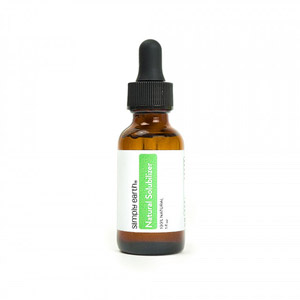Learn how to make your own DIY perfume with spring essential oil blends. Each natural perfume recipe has a captivating fragrance, and is made with essential oils that can help boost energy, brighten your mood, and banish the winter blues!
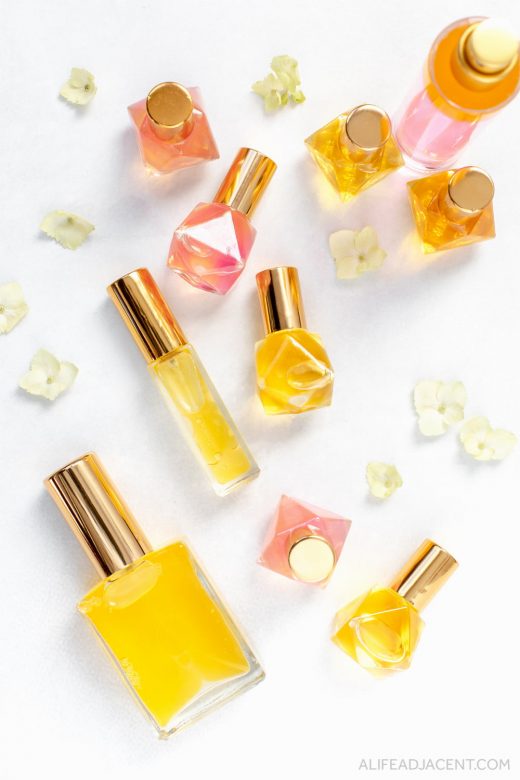
There are many reasons why we may feel blue from time to time, such as when the cold weather and dark and gloomy skies dampen our spirits.
But if and when the winter blues do hit, aromatherapy can be a fast and natural way to help improve your mood. And one of the easiest ways to incorporate aromatherapy into your day is with a DIY essential oil perfume spray or roll-on.
Sometimes wearing a bright springtime fragrance is just what you need to brighten your mood in the wintertime!
In this post, I will teach you how to make 5 aromatherapy perfume recipes with bright and uplifting spring essential oil blends: Daydream, Happy Day, Hope For Tomorrow, Tropical Escape, and Springtime Love.
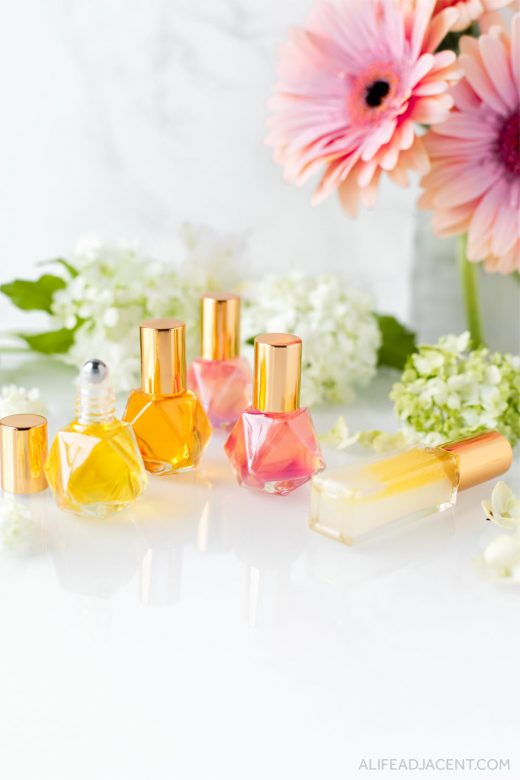
Not only do these blends smell lovely, but they can also help energize you and uplift you. Depending on your preference, you can make each perfume in spray or roll-on format, or in larger quantities for a scented body spray.
These perfume recipes are evocative of spring thanks to a plethora of floral and fruity notes, but they would also be well suited as summer perfumes as well.
Even if you’re eager to get straight to the recipes, I encourage you to read the whole post, because I’ll also be sharing helpful tips and tricks on the perfume-making process.
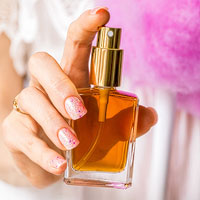
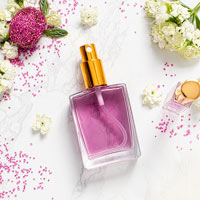
- Benefits of aromatherapy perfume
- Easy steps to making your own spring perfume
- Ingredients for spring aromatherapy perfume
- The best essential oils for perfume
- 5 Essential Oil Perfume Blends for Spring
- Spring essential oil perfume recipe
- Tips and tricks for making the best aromatherapy perfume
- How to use your aromatherapy perfume
Benefits of aromatherapy perfume
One of the biggest advantages that natural perfumes have over conventional fragrances is their aromatherapeutic properties.
Unlike synthetic fragrances, essential oils contain natural aromatic compounds that can influence our biology. Many possess calming, mood-boosting, and mind-altering properties.
As such, essential oils provide so many more benefits than simply smelling good!

The essential oils used in these spring perfume recipes boast a variety of aromatherapeutic benefits. Some essential oils that are beneficial for perfume include:
- Basil. Basil oil may help lessen headaches and feelings of stress and anxiety1,2.
- Ylang-ylang. Smelling ylang-ylang oil can boost self-esteem and decrease stress3,4.
- Grapefruit. The aroma of grapefruit oil is energizing and can help decrease food cravings5.
- Geranium. Multiple studies have shown that geranium oil’s fragrance decreases anxiety and markers of stress6.
- Blood Orange. The aroma of citrus oils can enhance mood, decrease anxiety, and promote relaxation7.
- Sandalwood. Sandalwood oil has anxiolytic effects and can help decrease the physiological stress response8.
- Ho Wood. Essential oils rich in linalool (such as ho wood) can help counteract anxiety, including social anxiety9,10.
- Patchouli. Patchouli oil helps control appetite, calm nerves, and reduce anxious feelings11.
- Bergamot. Bergamot oil is commonly used against stress and anxiety, and it can help lower the stress hormone cortisol12.
Of course, this isn’t to say that smelling essential oils is going drastically change your life or fix any problems. However, they just might help provide the pick-me-up we all need from time to time.
I like to keep a few botanical perfumes or aromatherapy roll-ons at my desk to use when I need a boost or when I feel my energy, focus, or creativity waning.
Easy steps to making your own spring perfume
Making your own DIY perfume might sound daunting, but it’s incredibly simple, and can be broken down into a few easy steps.
Step 1: Choose your essential oils.
The first and most important step to making your own natural perfume is of course to choose your desired fragrance.
Perhaps you love floral perfumes, or maybe you like your fragrances more on the fruity side. As well, consider whether you enjoy strong woody notes like sandalwood, or if you’d prefer the sweeter, more subtle aromas of amyris or ho wood.
Whatever your preference, I have provided 5 spring perfume blends to choose from, each with aromatherapeutic properties. They can be found in the section below with more information about each fragrance.
You can also find many of the essential oils required for these perfume recipes in Simply Earth’s February 2021 Essential Oil Recipe Box.
All supplies, including essential oils and perfume bottles, are always available for purchase on the Simply Earth site.
Step 2: Choose your perfume base and format.
The second step to making your own perfume is choosing your base and format. In other words, whether you’d like an alcohol-based perfume spray or a roll-on perfume oil.
As well, if you’d like to make an aromatherapy body spray, simply make a larger batch.
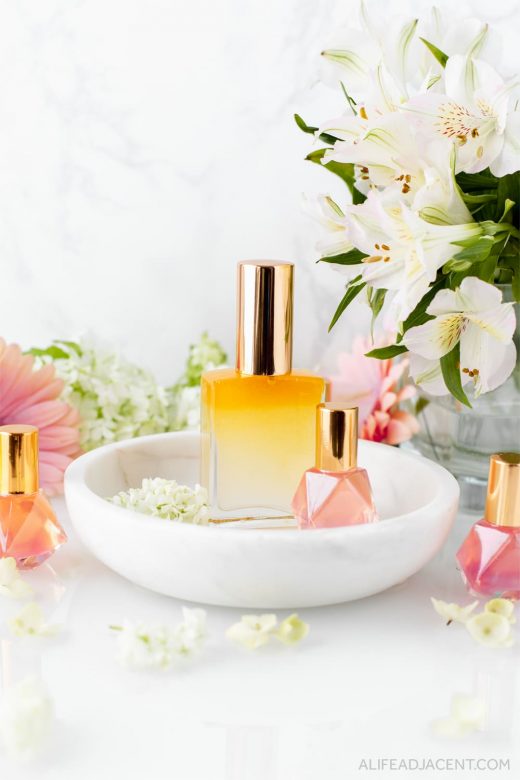
Step 3: Blend your perfume and allow to rest.
The next step is simply to blend your perfume. Place your essential oils in your atomizer or roller bottle, and fill with your base.
If desired, you can also let your perfume sit, or rest, before use. Leaving it to rest will allow the essential oils to meld with each other, deepening your fragrance.
It’s similar to the difference in flavour between adding seasoning during cooking, or allowing a dish to marinate before preparing.
Resting time is a matter of personal preference, and may vary from a few days up to several weeks. However, it’s not necessary, and there’s nothing wrong with using your perfume immediately.
Its fragrance will deepen with age, allowing you to enjoy each stage of its evolution.
Step 4: Enjoy!
Of course, the last step is to enjoy your aromatherapy perfume! Not only will they make you smell lovely, but they can also energize you, improve your focus, and uplift your mood.
Aside from the obvious route of applying to pulse points, I’ll share a few different ways to use your perfume in a later section.
Ingredients for spring aromatherapy perfume
You will need the following ingredients for your homemade perfume:
- Essential oils. Obviously, essential oils are what provide fragrance and aromatherapeutic properties to your perfume. I provide 5 blends below.
- Alcohol or witch hazel. If making a perfume spray, you will need a liquid base for your fragrance. Alcohol is preferable. Choose the highest-proof vodka or grain spirits available to you, such as Everclear (the best option). But if you’d like to make a perfume without alcohol, you can also use witch hazel.
- Fractionated coconut oil. This is required to dilute your essential oils to a safe skin concentration. Not all carrier oils are suitable, and certain oils spoil more quickly. I like fractionated coconut oil or MCT oil as they are the most stable liquid carrier oils, prolonging your perfume’s shelf life.
- Emulsifier: Oil and water don’t mix. So, an emulsifier helps prevent floating puddles of oil in your perfume or body spray. Using one is optional, but it’s recommend for a uniform formula. Otherwise, you should shake your perfume vigorously before use to disperse the oils. More on emulsifiers in the tips and tricks section.
- Extras. If desired, you can also colour your perfumes for a touch of beauty. One way to do this is by infusing your perfume with flowers, which is very fitting for spring. To do this, soak flowers in your alcohol or witch hazel, strain them out, and use for your perfume base. You can also add mica powder to add a hint of shimmer. However, this is only recommended for a roll-on perfume, as mica can clog small perfume atomizers.

The best essential oils for perfume
One of the most important parts of making your own aromatherapy perfume is choosing high quality essential oils.
Not all oils are created equal. How an oil is sourced and produced can make a huge difference in its purity, efficacy, and scent quality.
For instance, some varieties of ylang-ylang oil smell delightful, while others smell like rotting flowers. I used to think I didn’t like ylang-ylang for this reason!
This is why it’s so vital to choose a reputable brand. I like Simply Earth essential oils, as not only are they affordable, but each of their oils is ethically sourced and tested for purity.
Most of the perfume recipes provided are from Simply Earth’s Essential Oil Recipe Box. The February 2021 included an assortment of beautiful mood-boosting essential oils that are perfect for DIY perfume: Geranium, Basil, and two uplifting blends called Happy Joy and Lava.
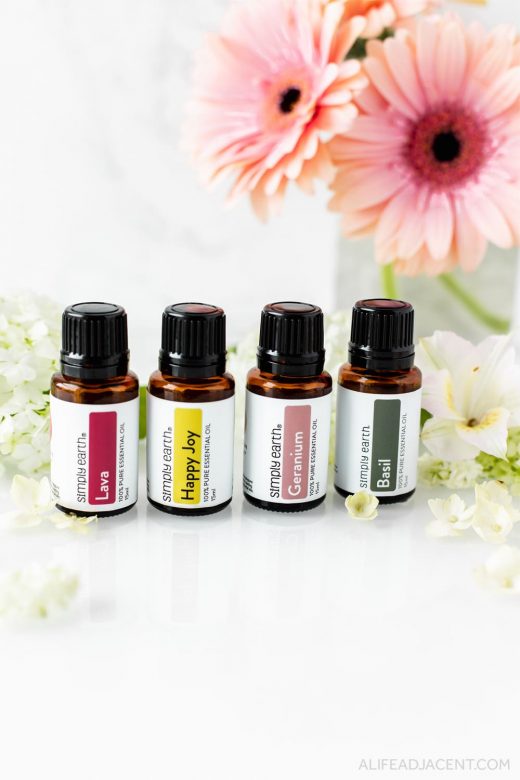
Perfect for uplifting your mood, Happy Joy is a cheery blend of geranium, sweet orange, grapefruit, and ylang-ylang that’s like sunshine in a bottle. Its aroma is crisp, fresh, and sweet, and reminds me of creamsicles and summer days.
Lava is a stunning blend that’s reminiscent of the tropics, sun-drenched volcanic beaches, and fresh orange juice. It blends a sweet and juicy base of blood orange and grapefruit with hints of ho wood and sandalwood for earthy depth.

Along with the essential oils, Simply Earth’s February box also included 3 perfume recipes and 2 beautiful perfume bottles.
If you’re interested, you can use our code ALIFEADJACENTFREE to get a $40 gift card with your box.
Now, let’s get into the perfume recipes.
5 Essential Oil Perfume Blends for Spring
Happy Day
2 drops Happy Joy essential oil blend
2 drops Lava essential oil blend
Top notes: Sweet Orange, Blood Orange, Grapefruit
Middle notes: Geranium, Ylang-Ylang, Ho Wood
Base notes: Sandalwood
Aromatherapy Benefits: Helps boost mood, calm anxiety, encourage positivity and feelings of happiness, decrease cravings, increase energy, improve focus, promotes confidence

If you love fruity perfumes, you will adore this effervescent blend!
This sunny perfume recipe balances the smallest hint of floral geranium with a plethora of sweet citrus fruits, encouraging happiness and energy.
Creamy ylang-ylang and slightly herbaceous ho wood add a tropical middle note, while a touch of rich, slightly smoky sandalwood anchors the blend.
Floral scents can be overwhelming, especially for those with sensitive noses. So, the Happy Day fragrance is perfect for those who like a hint of flowers in their perfume, as there’s more than enough juicy citrus notes to offset the rosy geranium.
Daydream
2 drops Happy Joy essential oil blend
2 drops Lava essential oil blend
1 drop geranium essential oil
Aromatherapy Benefits: Helps improve mood, calm nervousness, inspire creativity, encourage positive feelings, decrease cravings, increase energy and focus
Top notes: Sweet Orange, Blood Orange, Grapefruit
Middle notes: Geranium, Ylang-Ylang, Ho Wood
Base notes: Sandalwood

Daydream is a calming blend that inspires creativity and focus. It combines the same notes as Happy Day, but this time with an extra dose of dreamy geranium to transport your mind.
It’s well suited to those who like feminine, floral perfumes combined with fruity sweetness. Since geranium smells a lot like rose, it’s also perfect for those who love rose perfumes and romantic fragrances.
Over time, the citrus top notes will fade to reveal a more floral scent as the day goes by. Just another reason why Daydream is a lovely springtime perfume.
Hope for Tomorrow
2 drops Happy Joy essential oil blend
2 drops Lava essential oil blend
1 drop basil essential oil
Top notes: Basil, Sweet Orange, Blood Orange, Grapefruit
Middle notes: Geranium, Ylang-Ylang, Ho Wood
Base notes: Sandalwood
Aromatherapy Benefits: Helps inspire hope, boost mood, calm racing thoughts, encourage happiness, decrease cravings, boost energy, improve focus, bring clarity

When the winter blues set in, this aromatherapy perfume can help remind you that spring is right around the corner.
Basil makes for a refreshing botanical top note. It adds a crisp, zesty quality that can help to bring clarity and improve your energy when you’re feeling gloomy.
Three sunny citrus notes from sweet orange, blood orange and grapefruit inspire hopeful feelings, while geranium and woody undertones promote a sense of calmness and grounding.
Tropical Escape
2 drops Lava essential oil blend
2 drops ylang-ylang essential oil
1 drop patchouli essential oil
Top notes: Sweet Orange, Blood Orange, Grapefruit
Middle notes: Ylang-Ylang, Ho Wood
Base notes: Patchouli, Sandalwood
Aromatherapy Benefits: Helps energize, uplift mood, promote calm, improve focus, encourage happiness, decrease food cravings, promote grounding

If you’re feeling the urge to escape to somewhere warm, this energizing and intoxicating perfume blend will transport you to a sunny tropical paradise.
Simply Earth’s Lava blend evokes images of volcanic islands and tropical fruit. So, it’s the perfect pair to ylang-ylang, which adds a tropical feel with its exotic floral fragrance.
Ho wood adds subtle woodiness, like a palm tree. Finally, patchouli and sandalwood anchor the blend, adding a grounding, earthy note like the smell of volcanic sands. These oils also slow down evaporation for an amazingly long lasting perfume.
A tropical escape in the spring, this blend would be just as suited to a summer perfume. For a more fruity perfume recipe, you can simply omit the patchouli oil, as its earthy quality isn’t for everyone.
Springtime Love
1 drop amyris essential oil
1 drop ylang-ylang essential oil
1 drop bergamot essential oil
1 drop sweet orange essential oil
Top notes: Sweet Orange, Bergamot
Middle notes: Ylang-Ylang
Base notes: Amyris
Aromatherapy Benefits: Promotes affection and attraction, helps boost self-esteem and self-love, decrease stress, uplift mood, promote relaxation, improve focus, encourage positivity
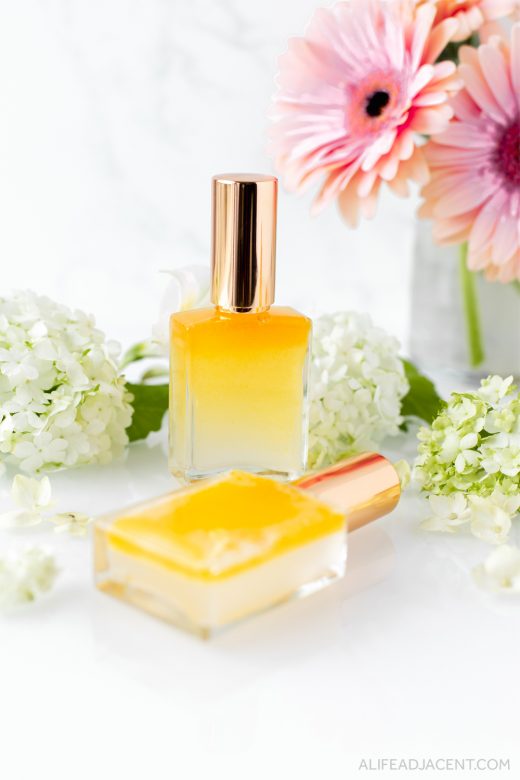
This romantic perfume is based on Simply Earth’s Love blend, which also comes in a pre-blended roll-on format.
Springtime Love is a captivating combination of amyris, ylang-ylang, sweet orange and bergamot. This sensual fragrance evokes feelings of love and affection. It can also help foster self-love, self-esteem, and lightheartedness with its sweet, candy-like fragrance.
As well, the oils in this blend can help decrease stress. In particular, smelling bergamot can lower the stress hormone cortisol, and ylang-ylang is useful for anxiety.

Spring Essential Oil Perfume Recipe
Perfume Spray
~5-10ml vodka, high-proof alcohol or witch hazel
1/2 tsp (2.5ml) fractionated coconut oil
Essential oil perfume blend (blends above)
1/2 tsp (2.5ml) liquid emulsifier or solubilizer (optional, see notes)
1 drop vitamin E (optional, see notes)
Roll-On Perfume
~10ml fractionated coconut oil
Essential oil perfume blend (blends above)
1 drop vitamin E (optional, see notes)
Equipment
Tiny funnel (these ones fit 10ml bottles)
10ml perfume spray bottle or crystal roller bottle (both also available directly from Simply Earth)
Glass pipettes for measuring
How to make perfume spray
- If using a liquid emulsifier or solubilizer, you’ll add this first. Using a tiny funnel and a pipette, add your emulsifier to your perfume bottle.
- Carefully drop your essential oils into the bottle.
- Replace the nozzle and shake to suspend the oils in the emulsifier.
- Add fractionated coconut oil (and vitamin E, if desired). Then once again replace the lid and shake to combine.
- To complete your perfume spray, add vodka, high-proof alcohol or witch hazel to fill your bottle. Shake well before each use.
How to make roll-on perfume oil
- Using a tiny funnel and a pipette, drop fractionated coconut oil into your roller bottle.
- Carefully add in your essential oils. If desired, add vitamin E.
- Pop in the rollerball, secure the lid and shake to combine.
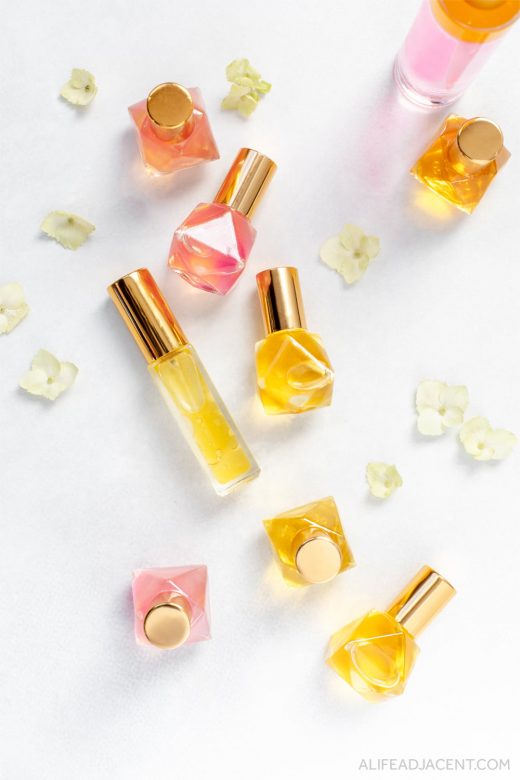
Tips and tricks for making the best aromatherapy perfume
Perfume making tips
- For a 2% dilution, use 4 drops of essential oils per 10ml of perfume or body spray.
- Using glass droppers with markings makes it easy to measure each ingredient precisely.
- If you’d like to make an essential oil body spray, simply double (or triple) the recipe and use a larger spray bottle.
Storage and shelf life
- Use your perfume within 6 months, as citrus oils have short shelf lives.
- Clear glass bottles are pretty, but technically not the best storage method for essential oils. Be sure to keep your perfume in a dark place when not in use, or better yet, opt for an amber bottle to protect the fragile oils.
- You can add a drop of vitamin E oil to your perfume to help keep the essential oils from oxidizing (going bad). It won’t stop the process completely, but may slow it down.
Safety tips
- Please ensure to clean and sanitize your containers and equipment before making your perfume.
- Patch test your perfume before use, and don’t use it if irritation occurs.
- If using witch hazel as your base, make sure the product contains a preservative.
- Do not use plain water in place of witch hazel or alcohol, as this will allow mold and bacterial growth in your perfume.

A note on emulsifiers
Simply Earth does their best to make their recipes accessible and simple for anyone to make. Their perfume spray recipe doesn’t contain an emulsifier. However, it does contain a carrier oil to ensure the essential oils are diluted for skin use.
As I mentioned previously, oil and water don’t mix. So, this means that unless you add an emulsifier, the essential oils will float on top of your perfume spray.
The choice is yours. Either way, always be sure to shake well before each use. Adding an emulsifier helps disperse the essential oils more evenly in your perfume or body spray, but it may still separate in storage.
The following solubilizers and liquid emulsifiers can all be used in perfume. You can choose whichever one is most accessible to you, as certain products may not be available in your area.
Natural emulsifiers for perfume include:
- CreamMaker FLUID (Canada or USA)
- Polyglyceryl Oleate
- Poly Suga Mulse D9
- Caprylyl/Capryl Glucoside
- Emulsium (Canada only)
If you are using an emulsifier in your perfume formula, you can skip the fractionated coconut oil and simply replace it with an equal amount of alcohol or witch hazel.
As well, please note that depending on which emulsifier you use, your perfume may turn cloudy. It won’t look quite as pretty in the bottle, but it will work better.
How to use your aromatherapy perfume
- Apply to pulse points: wrists, inside the elbow, and behind the ears are just a few examples. For a long-lasting fragrance, be sure to moisturize skin first, as hydrated skin holds scent longer.
- Keep your perfume at your desk and reapply when you want to boost your energy, mood, or focus. You can also spray it into the air around you for an uplifting room spray.
- If you have sensitive skin, you can spritz your perfume onto clothes for a fresh scent. However, essential oils can stain fabrics, so only do this if you’ve tested it in an inconspicuous area beforehand.
- Hair is very porous, so it’s great at absorbing and diffusing aromas, including essential oils. Use your creation as a hair perfume to catch a whiff of energizing fragrance throughout the day. Spritz directly onto hair, or, apply your perfume oil to your fingertips and smooth onto your hair’s ends. Just be sure to wash your hands after so you don’t accidentally get essential oils on your face or in your eyes.
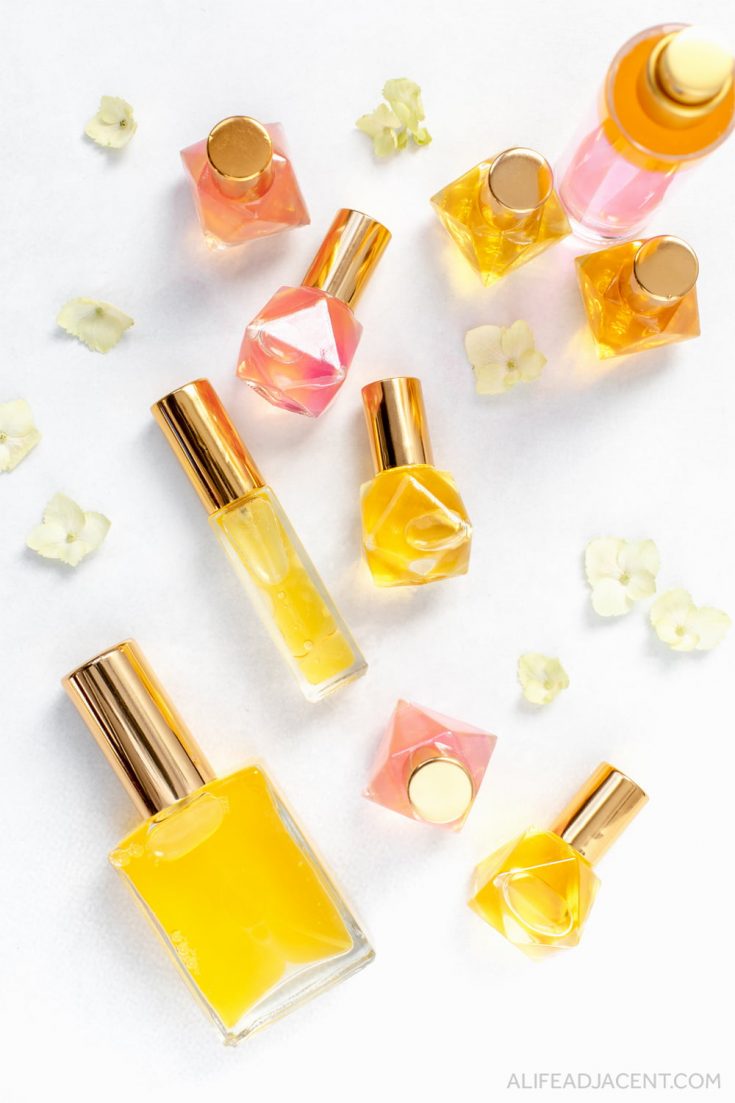
5 Essential Oil Perfume Recipes for Aromatherapy
Learn how to make your own DIY perfume with essential oils for spring! Discover 5 fruity and floral perfume recipes using spring essential oil blends. Choose between homemade perfume spray or aromatherapy roll-on.
Ingredients
Perfume Spray
- 5-10ml vodka, high-proof alcohol or witch hazel
- 1/2 tsp / 2.5ml fractionated coconut oil
- Essential oil perfume blend (blends below)
- 1/2 tsp / 2.5ml liquid emulsifier or natural essential oil solubilizer
- 1 drop vitamin E
Roll-On Perfume
- 10ml liquid coconut oil
- Essential oil perfume blend (blends below)
- 1 drop vitamin E
Happy Day Perfume Blend
- 2 drops Happy Joy essential oil blend
- 2 drops Lava essential oil blend
Daydream Perfume Blend
- 2 drops Happy Joy essential oil blend
- 2 drops Lava essential oil blend
- 1 drop geranium essential oil
Hope for Tomorrow Perfume Blend
- 2 drops Happy Joy essential oil blend
- 2 drops Lava essential oil blend
- 1 drop basil essential oil
Tropical Escape Perfume Blend
- 2 drops Lava essential oil blend
- 2 drops ylang-ylang essential oil
- 1 drop patchouli essential oil
Springtime Love Perfume Blend
- 1 drop amyris essential oil
- 1 drop ylang-ylang essential oil
- 1 drop bergamot essential oil
- 1 drop sweet orange essential oil
Tools
- Tiny funnel for 10ml bottles
- 10ml perfume spray bottle or crystal roller bottle
- Glass pipettes for measuring
Instructions
How to make essential oil perfume spray
- If using a liquid emulsifier or solubilizer, add this first. Using a tiny funnel and a pipette, add your emulsifier to your perfume bottle.
- Carefully drop your essential oils into the bottle.
- Replace the nozzle and shake to suspend the oils in the emulsifier.
- Add fractionated coconut oil (and vitamin E, if desired). Then once again replace the lid and shake to combine.
- To complete your perfume spray, add vodka, high-proof alcohol or witch hazel to fill your bottle.
- Shake well before each use.
How to make roll-on aromatherapy perfume oil
- Using a tiny funnel and a pipette, drop fractionated coconut oil into your roller bottle.
- Carefully add in your essential oils. If desired, add vitamin E.
- Pop in the rollerball, secure the lid and shake to combine.
Notes
Tips for making perfume with essential oils
For a 2% dilution, use 4 drops of essential oils per 10ml of perfume or body spray.
Using glass droppers with markings makes it easy to measure each ingredient precisely.
If you'd like to make an essential oil body spray, simply double (or triple) the recipe and use a larger spray bottle.
Storage and shelf life
Use your perfume within 6 months, as citrus oils have short shelf lives.
Clear glass bottles are pretty, but technically not the best storage method for essential oils. Be sure to keep your perfume in a dark place when not in use, or better yet, opt for an amber bottle to protect the fragile oils.
You can add a drop of vitamin E oil to your perfume to help keep the essential oils from oxidizing (going bad). It won't stop the process completely, but may slow it down.
Safety tips
Please ensure to clean and sanitize your containers and equipment before making your perfume.
Patch test your perfume before use, and don't use it if irritation occurs.
If using witch hazel as your base, make sure the product contains a preservative.
Do not use plain water in place of witch hazel or alcohol, as this will allow mold and bacterial growth in your perfume.
Emulsifiers
The following solubilizers and liquid emulsifiers can all be used in perfume. You can choose whichever one is most accessible to you, as certain products may not be available in your area.
Natural emulsifiers for perfume include:
Caprylyl/Capryl Glucoside (from Simply Earth)
CreamMaker FLUID
Polyglyceryl Oleate
Poly Suga Mulse D9
Emulsium
Recommended Products
As an Amazon Associate and member of other affiliate programs, we earn from qualifying purchases.
More natural ways to smell good
For more essential oil perfume recipes, check out:
If you’re looking for the perfect complement to your perfume, check these out:
- DIY Deodorant Spray with Essential Oils
- The Best Essential Oils for Body Odor
- Sugar Cookie Body Butter Recipe
- DIY Honey Almond Soap
Pin it for later
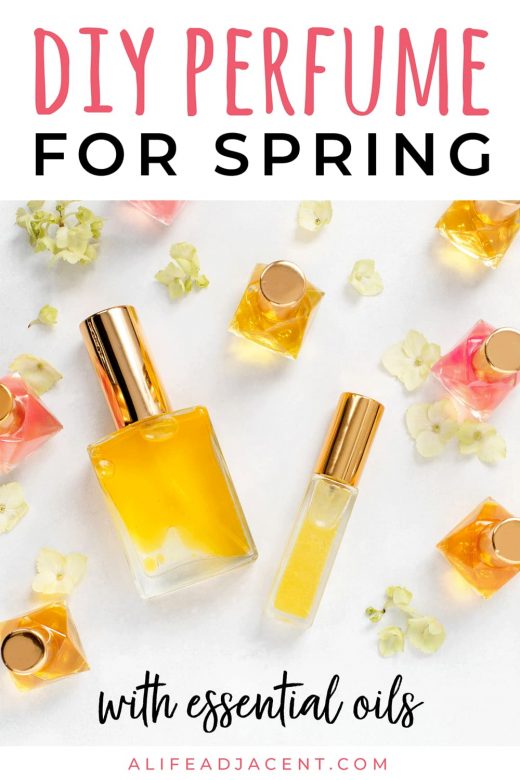

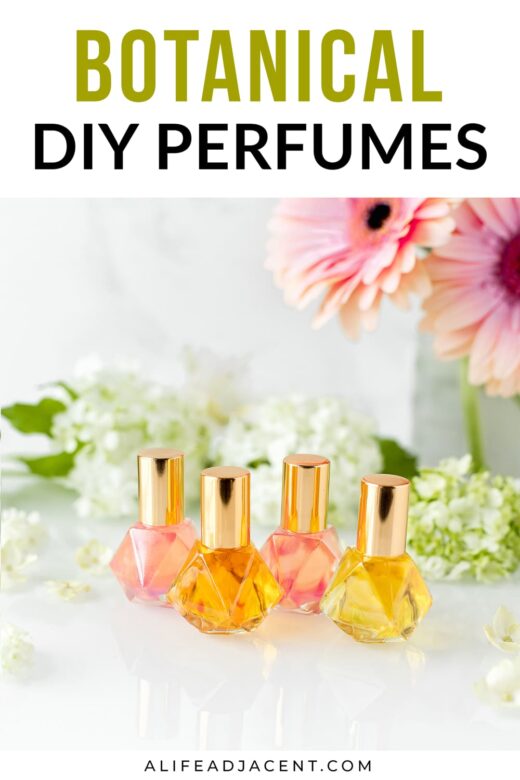
- Ahmadifard, Mahdieh et al. “The Efficacy of Topical Basil Essential Oil on Relieving Migraine Headaches: A Randomized Triple-Blind Study.” “Wirksamkeit von topischem ätherischem Basilikumöl zur Reduktion von Migränekopfschmerzen: eine randomisierte Studie.” Complementary medicine researchvol. 27,5 (2020): 310-318. doi:10.1159/000506349
- Rabbani, Mohammed et al. “Evaluation of anxiolytic and sedative effect of essential oil and hydroalcoholic extract of Ocimum basilicum L. and chemical composition of its essential oil.” Research in pharmaceutical sciences vol. 10,6 (2015): 535-43.
- Gnatta, Juliana Rizzo et al. “Aderência ao tratamento por estatinas e fatores associados em usuárias do Sistema Único de Saúde” [Aromatherapy with ylang ylang for anxiety and self-esteem: a pilot study]. Revista da Escola de Enfermagem da U S Pvol. 48,3 (2014): 492-9. doi:10.1590/s0080-623420140000300015
- Hongratanaworakit, Tapanee, and Gerhard Buchbauer. “Relaxing effect of ylang ylang oil on humans after transdermal absorption.” Phytotherapy research : PTR vol. 20,9 (2006): 758-63. doi:10.1002/ptr.1950
- Dosoky, Noura S, and William N Setzer. “Biological Activities and Safety of Citrusspp. Essential Oils.” International journal of molecular sciences vol. 19,7 1966. 5 Jul. 2018, doi:10.3390/ijms19071966
- Rashidi Fakari, Fahimeh et al. “Effect of Inhalation of Aroma of Geranium Essence on Anxiety and Physiological Parameters during First Stage of Labor in Nulliparous Women: a Randomized Clinical Trial.” Journal of caring sciences vol. 4,2 135-41. 1 Jun. 2015, doi:10.15171/jcs.2015.014
- Dosoky, Noura S, and William N Setzer. “Biological Activities and Safety of Citrusspp. Essential Oils.” International journal of molecular sciences vol. 19,7 1966. 5 Jul. 2018, doi:10.3390/ijms19071966
- Höferl, Martina et al. “A Pilot Study on the Physiological Effects of Three Essential Oils in Humans.” Natural product communicationsvol. 11,10 (2016): 1561-1564.
- Linck, V M et al. “Effects of inhaled Linalool in anxiety, social interaction and aggressive behavior in mice.” Phytomedicine : international journal of phytotherapy and phytopharmacology vol. 17,8-9 (2010): 679-83. doi:10.1016/j.phymed.2009.10.002
- Caputo, Lucia et al. “Lavandula angustifolia Essential Oil and Linalool Counteract Social Aversion Induced by Social Defeat.” Molecules (Basel, Switzerland) vol. 23,10 2694. 19 Oct. 2018, doi:10.3390/molecules23102694
- Swamy, Mallappa Kumara, and Uma Rani Sinniah. “A Comprehensive Review on the Phytochemical Constituents and Pharmacological Activities of Pogostemon cablin Benth.: An Aromatic Medicinal Plant of Industrial Importance.” Molecules (Basel, Switzerland) vol. 20,5 8521-47. 12 May. 2015, doi:10.3390/molecules20058521
- Watanabe, Eri et al. “Effects of bergamot ( Citrus bergamia (Risso) Wright & Arn.) essential oil aromatherapy on mood states, parasympathetic nervous system activity, and salivary cortisol levels in 41 healthy females.” Forschende Komplementarmedizin (2006) vol. 22,1 (2015): 43-9. doi:10.1159/000380989



